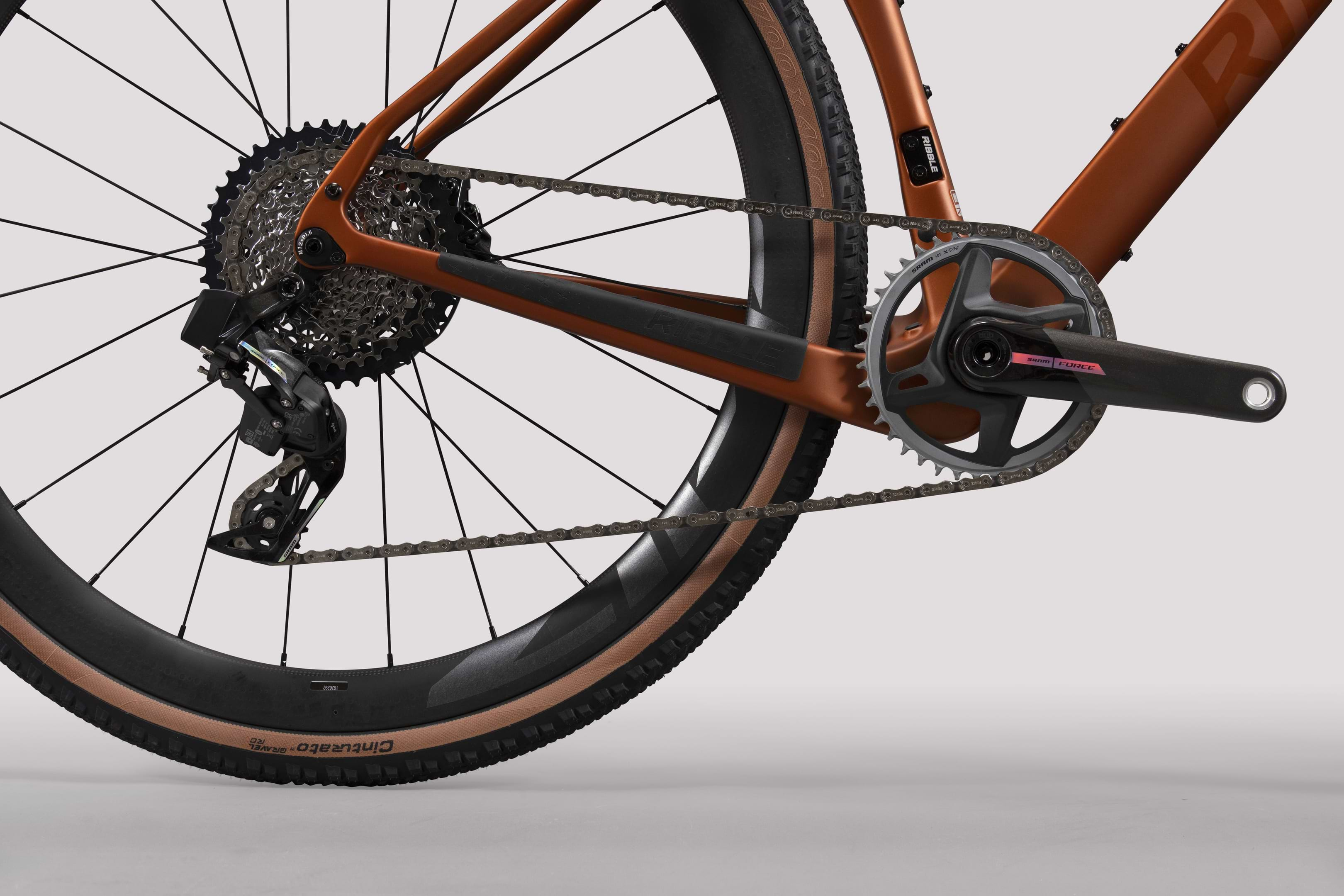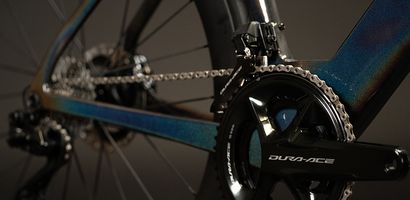
Bike Gears Explained - A Complete Guide
Picking the right gears has a dramatic effect on how your bike rides and how much (or little) you wish to suffer when the road heads upwards. Our gearing-explained guide decodes any biking gear terms to make you more gear-savvy when it comes to your bike’s spinny bits.
When deciding what gear ratios your new bike should have, it’s easy to get confused when navigating all the available options. So, we've put together this guide to help you decide on the right fit for your cycling needs.
What does 'Gearing' refer to?
Gearing on a bike refers to the system that allows the rider to adjust the bike's mechanical advantage to suit different riding conditions. It consists of a chainset (or crankset if you prefer) positioned at the front of the bike and a cassette (also known as sprockets or cogs) at the rear of the bike, which work together to change the gear ratio. More specifically, it’s about the number of teeth each component has: the more teeth (t) a chainring has, the harder it is to pedal.
The opposite is true for the rear cassette; the more teeth there are, the easier it is to pedal. Derailleur gears are mechanisms that move the chain between different chainrings and cogs to change gears. The Front Derailleur shifts the chain between the front chainrings, and the Rear Derailleur shifts the chain between the rear cogs.
The bottom line is to make ascents easier, you would need smaller chainrings at the front and larger sprockets at the rear.
Chainrings
A chainset typically consists of 1, 2, or (in rare instances) 3 chainrings.
The smaller the chain rings, the easier it is to spin the pedals.
Most bikes are supplied as standard with chainsets featuring one or two chainrings. A double chainset has an inner and outer chainring, with the inner being the 'climbing' ring because of its small number of teeth. The larger diameter outer chainring is better suited to flatter terrain and descents.
Chainring ratios
Single chainrings
- Also known as 'one by' (1x).
- The lack of a front derailleur adds simplicty and reduces maintenance requirements.
- Ideal for gravel riding. Cycling in difficult terrain, off-road demands a lower gear range than you would typically find on any road bike. The 1x single chainring is an ideal fit for this, and features predominantly on gravel bikes.
- Depending on the groupset, chainrings can be as small as 40t or as large as 44t.
Compact - 50/34
- The 50/34 ratio chainset has found great popularity among novice cyclists or seasoned roadies looking for more assistance on the climbs.
- It's often the default option for the majority of endurance and Allroad bikes currently available today.
- Both inner and outer chainrings are quite small, making pedalling easier, which comes in especially handy when you hit the climbs.
- However, the climbing assistance does come with a trade-off – the relatively small diameter outer ring will cause you to 'spin out' more quickly when descending
- Spinning out – When you pedal but there's insufficient tension on the chain to propel you forward - most commonly encountered when descending.
Semi-Compact - 52/36
Known as a semi-compact, this is an intermediate option for riders who still want some assistance on the hills but also desire more speed on the flats and descents. Rather than the 50/34 of compact, you now get 52/36 chainrings.
Race
- Not always strictly 53/39, but close enough!
- Now regarded as a rarity on today's bikes, but for the majority of the 20th century nearly every new bike would arrive with a ratio identical or similar to this.
- It was a standard 'race' setup and dates back to a time when your only options when buying a bike were simply double or triple-gearing.
- Today's bike racers will still use something very similar, albeit with a slightly larger outer ring.
- This ratio is fast on the flat but offers little assistance on the climbs. Therefore, only the supremely fit or dedicated road racers still use it.
Cassettes
A cassette is a collection of cogs that sits on the rear hub and provides a select gear range for every riding discipline. In direct contrast to the chainrings, the larger the sprocket is, the easier it is to pedal. Therefore, large sprockets are most advantageous for climbing.
For a wide-range cassette, note the increase in cog size. The closer to the top, the easier it is to pedal.
The groupset a bike is supplied with will determine whether the cassette has between 8 and 13 sprockets. Entry-level groupsets typically feature cassettes with 8 to 10 sprockets, whereas mid to top-tier variants feature 11 to 13.
Select an appropriate cassette ratio for the terrain you expect to ride most often. For most assistance on the ascents when riding on the road, an 11-32 to 11-36 will prove most beneficial. Closer ratio cassettes such as 11/25, 11/28 or 11/30 are better suited to riders with a high level of fitness or those who typically stick to flatter terrain. Single-ring systems will feature cassettes with a much wider spread - where anything between 11-42 and 10-51 is the norm.
Gear Ratios
Best Bike Gear Ratios for Climbing
You will normally find most new bikes specced with a 'Climbers ratio', featuring a 34/50 chainset combined with a 11/32, 11/34 or 11/36 tooth cassette. This ratio is recommended for beginners or existing road riders who want the maximum amount of assistance on the climbs. With both a small and large chainring at the front, there's no need for a massive cassette at the rear.
The advantage of this combination is that when you change gear, the jumps between each individual gear are less dramatic. The smaller the steps between gears are, the smoother the action is when shifting from one sprocket to the next. A smoother shift results in less interruption of your pedalling rhythm (cadence). This is more pronounced with 1x systems owing to their much bigger sprocket sizes.
Semi-Compact 36/52 with 11/25 to 11/36 Cassette
Amateur racers and riders with a decent fitness level may benefit from this setup. It still offers some assistance on the climbs thanks to its 36t inner chainring. However, it is the larger 52-tooth outer chainring that such riders value the most:
- The gap between gears is kept relatively small, which is ideal to avoid losing the pedalling rhythm when changing gears. Any loss of rhythm will also affect power output, making it less efficient. Therefore, opting for a smaller-spaced cassette like an 11/25 or 11/28 avoids any large jumps when changing gear.
- The gears do not 'spin out' as fast when descending. Spinning out is when you descend at such a velocity that when you attempt to pedal, your legs just spin furiously to zero effect. Sure, you can spin the pedals, but with no traction on the chain, it's just wasted effort. A larger outer chainring at the front means you can pedal for longer before losing chain traction.
- Specifying larger chainrings and/or closer cassette ratios makes the bike faster on the flat.
1x chainset with 11/42 to 10/44 Cassette
Such ratios will feature almost exclusively on gravel bikes, where the huge gear range is crucial to overcoming the obstacles most commonly associated with the most demanding off-road terrain.
Pick your perfect gear combination
The gearing loadout of a bike will depend entirely the type of riding the biks is intended for and the groupset it comes fitted with as standard.
A hybrid bike will often have a chainring as small as 32t at the front and a road ratio cassette between 11-32 and 11-36 at the rear.
Whereas gravel bikes will tend to be fitted with a larger chainring of approximately 40 to 44t in conjunction with a mountain bike ratio cassette between 11-42 and 10-44t. In reality, the gear range will be markedly similar, and you are less likely to be offered a choice of gearing when purchasing such a bike.
Winter Riding
Winter rides focus on building base miles and maintaining aerobic fitness, ensuring you're in peak physical condition when spring rolls around. The key to these rides is low-intensity, high-volume training, which requires adjusting your gearing accordingly. When navigating slippery roads or steep, icy inclines, it's essential to avoid grinding big gears. Instead, opt for smaller chainrings and larger sprockets to make your rides more manageable.
We hope this guide helps you understand what to choose when buying a new bike. If you need more assistance, please do not hesitate to contact us.
Looking to take up cycling? Check out our guide to find our top tips for prospective cyclists.
Looking to get fit or save some money? Find out why an e-bike could just be the solution that you are looking for.
Gravel explorers rejoice. The latest SRAM gravel groupset are now available on our gravel bikes. Discover what prompted the change in our groupset guide.



